The Importance and Types of Data Modeling in Data Science
Summary
Table of Content
As the amount of data generated every day increases exponentially, creating a logical, simplified database has become the need of the hour. This is why data modelling has become one of the most crucial aspects of Data Science. In this article, understand:
- the foundations of data modelling,
- the importance of data modelling,
- the different types and phases of data models
- some popular tools used to model data
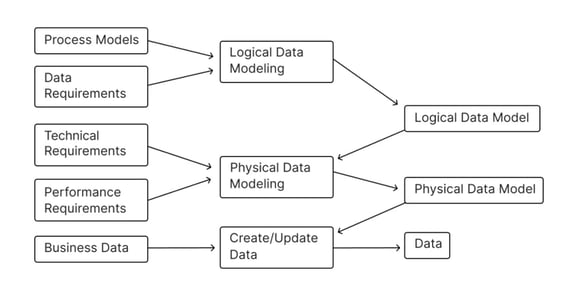 In the era of the digital world, we are generating massive amounts of data. For example, if you are a business analyst for a retail e-commerce company, you have cookies data such as browser details, IP address, location, adware, and so on. If you purchase online, there is a different set of information like product name, delivery address, quantity, price, and payment mode.
In the era of the digital world, we are generating massive amounts of data. For example, if you are a business analyst for a retail e-commerce company, you have cookies data such as browser details, IP address, location, adware, and so on. If you purchase online, there is a different set of information like product name, delivery address, quantity, price, and payment mode.
Suppose you want to identify which ad campaign significantly contributed to the sales that were made on your website. Storing, managing, and aggregating are different in this kind of scenario. It can be challenging to map cookies, campaign, and retail sales data to collaborate into one. Due to the same reason, we use data modelling to get maximum insights out of the data.
In this article, get familiar with the concept of data modelling, the different types and phases of data modelling, and the popular tools used to create data models.
What is Data Modelling?
Data modelling is the process of creating a meaningful relationship between tables based on text and symbols mentioned in the table.
Using data modelling, one can understand which campaign runs at what period from the campaign's data. Similarly, we have cookies information that collects the customer profile and e-commerce sales data to justify the sales.
You may also want to read Top Trending Technologies in IT.
Why is Data Modelling Important?
Various perks are associated with data modeling, identifying, and collaborating data. Which are as follows:
- High Quality: Data modelling can be a blueprint of the architecture and relationship of the data tables, which enables software developers to build scalable applications, data analysts with precise information, and a user to access product information on a website.
- Faster Performance: A well-constructed data model tends to be quicker and has an optimal performance compared to a model with poor data modelling skills. For example, when consuming the business intelligence dashboard, your CEO will have a pleasant experience using and understanding the visuals mentioned in the dashboard, which has the least latency.
- Good Documentation: Most all data models come with good documentation, which enables us to understand the relationship, and allows software developers to get the vital information related to data that enables faster development.
- Few/No Errors: Data errors are one of the worst errors you can face in a production environment. You may encounter issues such as an application crashing, data science models throwing errors due to the unavailability of the data, and so on. On the other hand, a data model leverages data quality.
- Data Mining: Data mining is a crucial step for any analytical model. If the data modelling is configured correctly, there won't be many data preparation and cleaning issues. An efficient data model can save a lot of time here.
Different Types of Data Models
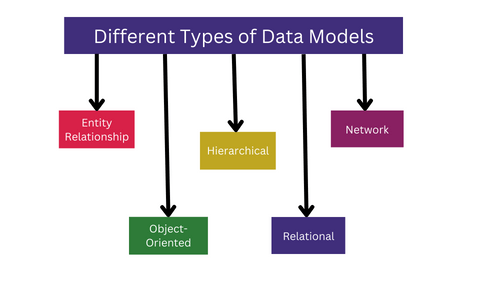 There are multiple options and procedures involved in data modelling. For planning a good data model, there are a series of discussions with key stakeholders to identify how the model is. For example, how does data need to be stored?
There are multiple options and procedures involved in data modelling. For planning a good data model, there are a series of discussions with key stakeholders to identify how the model is. For example, how does data need to be stored?
We have the following types of data modelling to determine most of these questions.
-
Hierarchical Models: These are such kinds of models where you have hierarchies with parent and child relationships—for example, the marketing manager reports to the marketing head. Similarly, the marketing head reports to the CEO. Hierarchical models have specific layers of hierarchy and reporting mechanisms.
-
E-R (Entity Relationship) Data Models: The models are known as ERD(Entity Relationship Diagram). Technical details are found in ERDs, making it easier for any candidate to see business information visually.
-
Object-oriented Data Model: Object-oriented data model is inspired by object-oriented programming. Objects are the level of information that contains attributes and behavior. Where an object is a piece of information like a to-do list and attributes are tasks like “Buy a Pen”, “Complete your assignment,” etc.
-
Relational Model - This model is considered an alternative to hierarchical data models. It provides a concrete overview of the data by bringing down complexity.
-
Network Model - The network model allows you to express very complex relationships as each record can be linked to several parent records.
A few other data models are also available but are not popular.
Phases of Data Modelling
As you have understood various types of data modelling, let us move on to the different phases of data modelling.
Conceptual Data Modelling: It is a structured approach to view the business required to support the process and help the business record information and performance measures. Conceptual data modelling helps us to understand the overall structure of the business data so that it can give a clear picture to any individual.
In this phase, there are three data model tenets: entity, attribute, and relationship.
-
Entity: Entity helps real-world things such as buses, pens, books, etc.
-
Attribute: Attribute helps us to understand the features of the entity, such as school bus, red pen, novel, etc.
-
Relationship: Relationship is the cardinality between the tables. For example, cars are stored on the car table and their attributes on another table. Relationships help us to aggregate quickly.
-
Logical Model: Logical data model, popularly known as LDM, helps us to understand the data visually where we can understand entities, attributes, keys, and relationships. LMDs help technical maps of routes and data structure in such a way any person can understand it by its visual. We can use a logical model to clarify how the model needs to be implemented in the DBMS. Majorly it is done by Data architects, sometimes Business analysts. Here the relationship between tables is also considered, wherein we can understand the primary and secondary keys and justify the connection.
-
Physical Data Model: Physical data models are used to understand the relationship between the tables, which are a layout of how the data is stored. These data models can be used along with DDL(Data Definition Language), which can help deploy the database. In the physical data model, we can integrate the data required for a specific project by using various other data models. In this phase, the determination of cardinality and table relationships is taken care of. The physical data model takes care of the primary key, foreign key, index, table views, and authorization.
Best Data Modelling Tools in 2022
Multiple data modelling tools are available in the market. These tools help understand data, efficient relationships, and database structures based on UML(Unified Modelling Language) diagrams.
Here are the top 3 data modelling tools in 2022:
ER/Studio
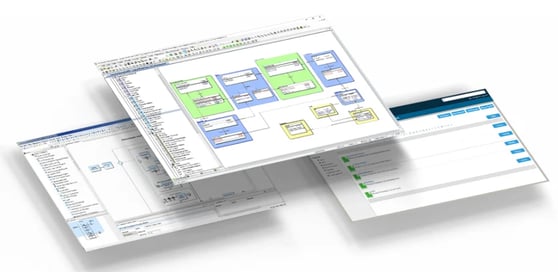 Source: https://www.idera.com/products/er-studio/enterprise-data-modeling/
Source: https://www.idera.com/products/er-studio/enterprise-data-modeling/
ER/Studio is one of the popular data modelling tools with state-of-the-art physical and logical data modelling capabilities. It is one of the oldest software in data modelling and was developed and managed by IDERA, INC. The tool can perform the following tasks:
-
Load multiple databases into the platform.
-
Create and manage the database.
-
Design documents and reuse data assets.
-
Built-in Business Glossary
-
Capacity planning.
-
Model completion validation.
-
Data lineage documentation and so on.
The price of the software depends on the users or workstation and costs around 1400 USD. Free tools are available from the same company, but the software is not for trial. You can learn the software by visiting this link.
Erwin Data Modeller
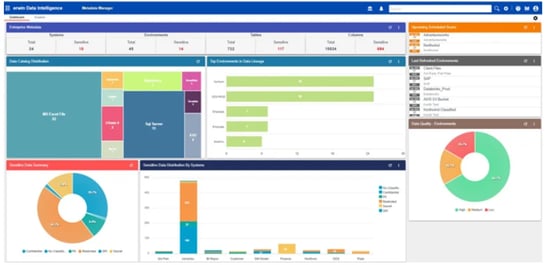 Source: https://www.erwin.com/products/erwin-data-modeler/
Source: https://www.erwin.com/products/erwin-data-modeler/
Erwin Data Modeler has over 30 years of experience in data modelling, wherein, we can find and design data before deploying. In addition, it has built-in integration with Postgrad SQL and MySQL databases.
The software was developed by Logicworks and is available on Microsoft (not available for MAC users). Previously, it was known as Erwin and came with the CASE tool(computer-aided software engineering). The price of the software depends on the user, which costs 3085 USD /user and 4880 USD/user.
Click on this link to buy or learn more about the software.
DB Schema
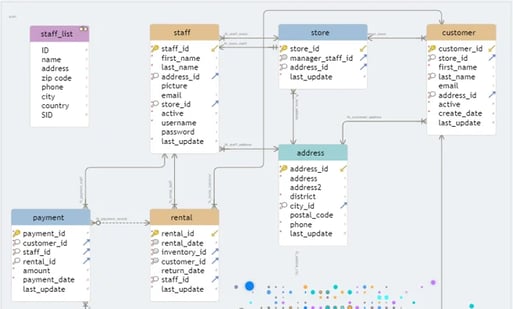 Source: https://dbschema.com/?AFFILIATE=44600&__c=1
Source: https://dbschema.com/?AFFILIATE=44600&__c=1
DB Schema can be a cheaper option which starts with a base price of 98 USD per user per academic. 196/user for individual/developers/admins. 294 USD for a commercial license. Free trials are also available.
DB Schema is a desktop tool as well as a cloud. Which can perform most of the operations like Erwin data modeller and ER/Studio but cannot facilitate forward engineering.
If you are planning to buy DB schema, visit this link.
How To Select Your Data Modelling Tool
Multiple parameters need to be considered before selecting any tool:
-
User interface: How well the user can understand and use the software/tool
-
Scalability: The tool is just for data understanding or can be used for further applicability.
-
Visualization: How well can we see the ER Diagrams and relationship
-
Active community: Active users and help if we get stuck with any issues.
-
Customization: Flexibility of the software and how we can use it
-
Collaboration: collaboration with SQL server, Oracle, etc. is essential
You may also want to read Nine Must-Have Data Analysis Tools To Create Dashing Business Reports.
Now, if you are looking for holistic training in the data domain, join OdinSchool's Data Science Course and learn all the in-demand skills hands-on. Talk to a career counsellor today!







